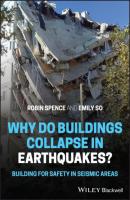Why do buildings collapse in earthquakes? Building for safety in seismic areas. Robin Spence
Чтение книги онлайн.

Читать онлайн книгу Why do buildings collapse in earthquakes? Building for safety in seismic areas - Robin Spence страница 20
Название: Why do buildings collapse in earthquakes? Building for safety in seismic areas
Автор: Robin Spence
Издательство: John Wiley & Sons Limited
Жанр: Отраслевые издания
isbn: 9781119619468
isbn:
The surprising conclusion is reached that, although the global annual loss rate has fluctuated somewhat over time, the trend has remained relatively constant, with a peak of 0.1% in 1949, reducing in more recent years to about half of this value. Thus, while production and population have increased enormously over the last century, and thus actual values of loss have increased correspondingly, there has been only a small decrease in the loss rate as a proportion of GWP. But this decrease is not enough to suggest that the problem of economic earthquake losses is being brought under control. For small poor countries such as Haiti, the total cost of a single event can be more than 100% of the country's GDP. Indeed, recent events have suggested that, given the increasing interconnectedness of the world's economy, the indirect losses are increasing and will become more dominant in future events (Daniell et al. 2012).
References
1 Asia Development Bank (2005). Pakistan 2005 Earthquake: Preliminary Damage and Needs Assessment. Islamabad: Asian Development Bank and World Bank.
2 Berberian, M. (2005). The 2003 Bam urban earthquake: a predictable seismotectonic pattern along the Western Margin of the Rigid Lut Block, Southeastern Iran. In: 2003 Bam Iran Earthquake Reconnaissance Report, Earthquake Spectra Publication No 2005‐04. California: Earthquake Engineering Research Institute.
3 Boen, T. (2016). Learning from Earthquake Damage: Non‐Engineered Construction in Indonesia. Indonesia: Gadjah Mada University Press.
4 Coburn, A. and Spence, R. (2002). Earthquake Protection. Wiley.
5 CRED (2020). The international disaster database. http://www.emdat.be (accessed 2020).
6 Daniell, J., Khazai, B., and Wenzel, F. (2012). The worldwide economic impact of historic earthquakes. Presented at the 15th World Conference on Earthquake Engineering, Lisbon, Portugal.
7 Daniell, J., Pomonis, A., Tsang, H.‐H. et al. (2018). The top 100 fatal earthquakes examining fatality risk reduction with respect to seismic code implementation. Proceedings: Presented at the 16th European Conference on Earthquake Engineering, Thessaloniki, Greece.
8 DesRoches, R., Comerio, M., Eberhard, M. et al. (2011). Overview of the 2010 Haiti earthquake. Earthquake Spectra 27: S1–S21.
9 EEFIT (2005). The Bhuj, India Earthquake of 26th January 2001. UK: EEFIT, Institution of Structural Engineers.
10 EEFIT (2006). The Indian Ocean Tsunami of 26.12.04: Mission Findings in Sri Lanka and Thailand (ed. A. Pomonis). London: Institution of Structural Engineers.
11 EEFIT (2008a). The Kashmir Pakistan Earthquake of 8th October 2005: A Field Report by EEFIT. London: Institution of Structural Engineers.
12 EEFIT (2008b). The Wenchuan Earthquake of 12th May 2008: A Preliminary Field Report by EEFIT. London: Institution of Structural Engineers.
13 EEFIT (2010). The Haiti Earthquake of 12th January 2010: A Field Report by EEFIT. London: Institution of Structural Engineers.
14 EEFIT (2011a). The Mw 6.3 Christchurch New Zealand Earthquake of 22nd February 2011: A Field Report by EEFIT. London: Institution of Structural Engineers.
15 EEFIT (2011b). The Mw 9.0 Tohoku Earthquake and Tsunami of 11th March 2011: A Field Report by EEFIT. London: Institution of Structural Engineers.
16 EEFIT (2015). The Mw 7.8 Gorkha, Nepal Earthquake of 25 April 2015: A Field Report by EEFIT. London: Institution of Structural Engineers.
17 EERI (1986). Reducing Earthquake Hazards: Lessons Learnt from Earthquakes. California: Earthquake Engineering Research Institute.
18 EERI (2005). First Report on the Kashmir Earthquake of October 8, 2005. EERI Newsletter 39:12. California: Earthquake Engineering Research Institute.
19 EERI (2006a). The Kashmir Earthquake of October 8, 2005: Impacts in Pakistan. EERI Newsletter 40:2. California: Earthquake Engineering Research Institute.
20 EERI (2006b). The Mw 6.3 Java, Indonesia, Earthquake of May 27, 2006. California: Earthquake Engineering Research Institute.
21 EERI (2008). The Wenchuan, Sichuan Province, China, Earthquake of May 12, 2008. California: Earthquake Engineering Research Institute.
22 EERI (2016). The M7.8 Gorkha Nepal Earthquake and Its Aftershocks. California: Earthquake Engineering Research Institute.
23 Foulser‐Piggott, R., Spence, R., Eguchi, R., and King, A. (2015). Using remote sensing for building damage assessment: GEOCAN study and validation for 2011 Christchurch earthquake. Earthquake Spectra 32: 1–21.
24 Galloway, B., Hare, J., Brunsden, D. et al. (2014). Lessons from the post‐earthquake evaluation of damaged buildings in Christchurch. Earthquake Spectra 30: 451–474.
25 Ghafory‐Ashtiany, M. and Mousavi, R. (2005). History geography and economy of Bam. Earthquake Spectra 21 (S1): S3–S11.
26 Ghosh, S., Huyk, C., Greene, M. et al. (2011). Crowdsourcing for rapid damage assessment: the global earth observation catastrophe assessment network. Earthquake Spectra 27 (1): S179–S198.
27 Government of Nepal (2015). Nepal Earthquake 2015: Post Disaster Needs Assessment, Volume A: Key Findings. Kathmandu: National Planning Commission, Government of Nepal.
28 Jain, S.K. (2016). Earthquake safety in India: achievements, challenges and opportunities. Bulletin of Earthquake Engineering 14: 1337–1436.
29 Jain, S.K., Lettis, W., Murty, C., and Bardet, J. (2002). Bhuj India Earthquake of January 26th 2001: Reconnaissance Report. EERI Special Report. California: EERI.
30 King, A., Middleton, D., Brown, C. et al. (2014). Insurance: its role in recovery from the 2010–2011 Canterbury earthquake sequence. Earthquake Spectra 30: 475–492.
31 Langenbach, R. (2015). What we learn from vernacular construction. In: Nonconventional and Vernacular Construction Materials: Characterisation, Properties and Applications (eds. K.A. Harries and B. Sharma). Woodhead Publishing.
32 Macabuag, J., Raby, A., Pomonis, A. et al. (2018). Tsunami design procedures for engineered buildings: a critical review. Proceedings of the Institution of Civil Engineers – Civil Engineering 171: 166–178.
33 Maheri, M., Naeim, F., and Mehrain, M. (2005). Performance of adobe buildings in the 2003 Bam earthquake. In: 2003 Bam Iran Earthquake Reconnaissance Report, Earthquake Spectra Publication No 2005‐04. California: Earthquake Engineering Research Institute.
34 Marshall, J., Lang, A., Baldridge, S., and Popp, D. (2011). Recipe for disaster: construction methods, materials and building performance in the January 2010 Haiti earthquake. Earthquake Spectra 27: S323–S344.
35 Moon, СКАЧАТЬ